Advertisement
A compression check can tell a lot about the health of your outboard engine. Here's why and how it's done.
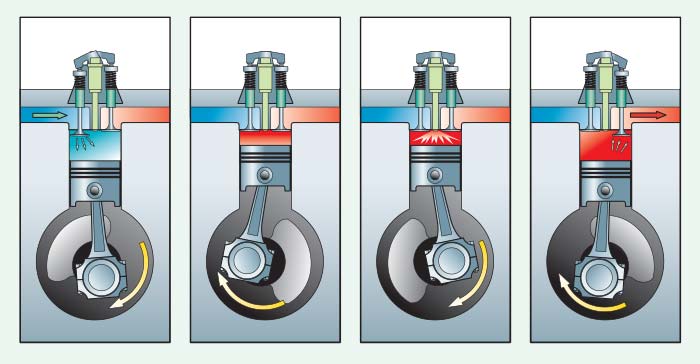
There are four distinct phases in a four-stroke cycle: induction, compression, power, and exhaust. A lot can be learned by checking the engine's ability to compress the gas/air mixture. (Illustration: ©2016 Mirto Art Studio)
An outboard gas engine needs air, fuel, spark, compression, and unobstructed exhaust — in the right amounts and at the right time. As the piston travels up and down in the cylinder, the piston rings seal against the cylinder wall so the air/fuel mixture can be compressed at the top of the cylinder on the upstroke. If the piston and rings can't compress the air-fuel mixture in the cylinder so the spark can ignite it, the engine won't run well, if at all. In addition, if the rings aren't sealing properly against the cylinder walls, they're not doing another job of transferring the heat from the pistons to the cylinder walls. Without that transfer, the piston would grow in size from the heat and "stick" inside the cylinder, causing damage.
A compression check can indicate that the piston rings are working properly and that the cylinders are in good condition. The test measures how much pressure is built up by the motion of the piston inside the cylinder, given in pounds per square inch (PSI). Even if you're not a trained technician, you might be mechanically inclined enough to do this diagnostic test. And even if you'd rather not attempt this yourself, understanding how the test works will let you evaluate what a mechanic tells you.
There are other diagnostic tests, such as a leak-down test, in which you measure the rate of air pressure leaking from a cylinder while the piston is in top-dead-center position. This also can help you determine whether an expensive teardown is needed.
Advertisement
In principle, the compression test is simple, but the many different types of outboards can add numerous important complexities. The following steps are only general guidance. Your engine may require different steps depending on factors such as whether it's a two- or four-stroke, has fuel injection, has computers onboard, is hand cranked or has a starter motor, and how its ignition can be disabled. These variations and other issues mentioned below will bear on your ability to do this yourself.
Pros tend to use good compression gauges from high-end companies like Snap-On and Mac. But you can also buy a reasonably good compression gauge at almost any local auto-parts store. It should work fine for occasional use. Get the right adapters to fit the spark plug holes in your engine.
There are advocates for checking compression on a cold engine, and those that advise doing it only on a warm engine. My vote is for the latter; it gives a reading that's accurate and relevant to the engine when it's running. If you're running the engine with the boat out of the water, follow the engine manual on how to do this — most likely, you'll need a set of outboard muffs or a barrel to provide cooling water. Begin with running your engine until it warms up to normal operating temperature, then follow this six-step process.
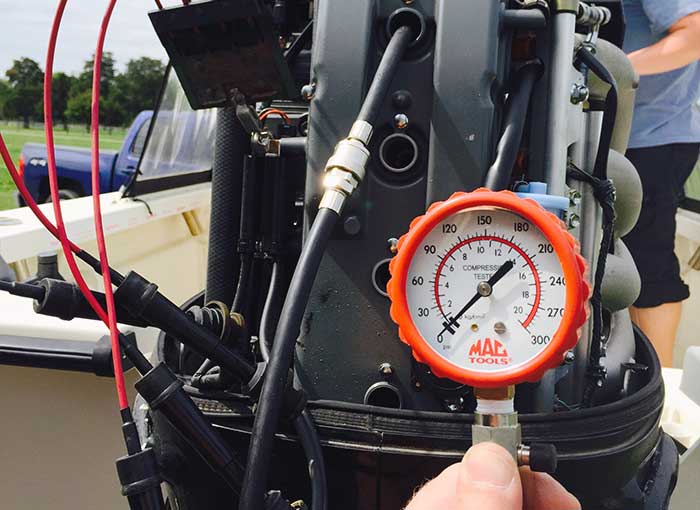
Checking your engine's cranking compression is a quick task that can reveal a lot if correctly performed.
1. Beware of the danger from a spinning propeller should you inadvertently start the engine or shift while setting up. Do what is required to prevent the ignition from firing. This may be simply pulling the engine kill switch. If you must disconnect the battery, you'll have to reconnect it to crank an electric start. Remove all the spark plugs. Number the leads so that you know where they go back.
If ignition occurs and the leads or plugs aren't properly grounded, the ignition could be damaged. Also, a spark could ignite fuel vapor emanating from the open cylinder. A spark tester for all plugs can help here.
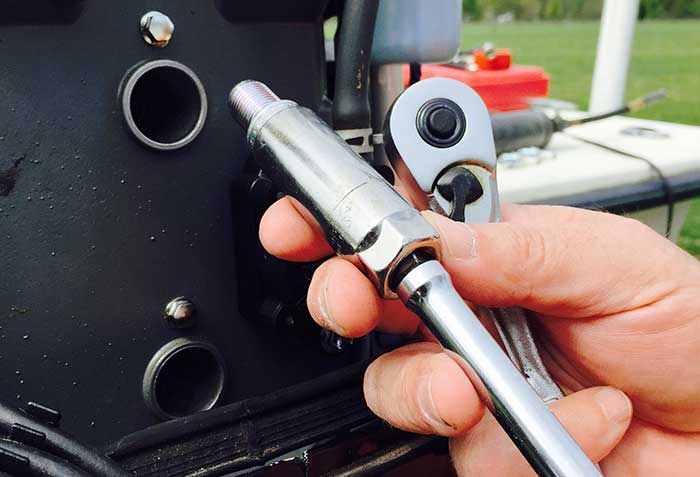
Remove the engine's spark plugs. Check them carefully for damage. The electrodes should be gapped properly, and their color should be a medium tan to brown after a high-speed run, dark brown to black after idling at slow speeds. If they're lighter-colored than that (light tan or white), the engine is running too lean — not enough fuel — and should be checked before damage occurs.
2. Many recommend moving the throttle well forward to facilitate air entering the cylinder as you crank the engine.
However, with an electric start, you may not be able to do this and also crank the engine unless you have a bypass button, usually in the throttle hub. If in doubt, consult your owner's manual. Also, some engines get enough air intake, without doing this, to do an adequate compression test.
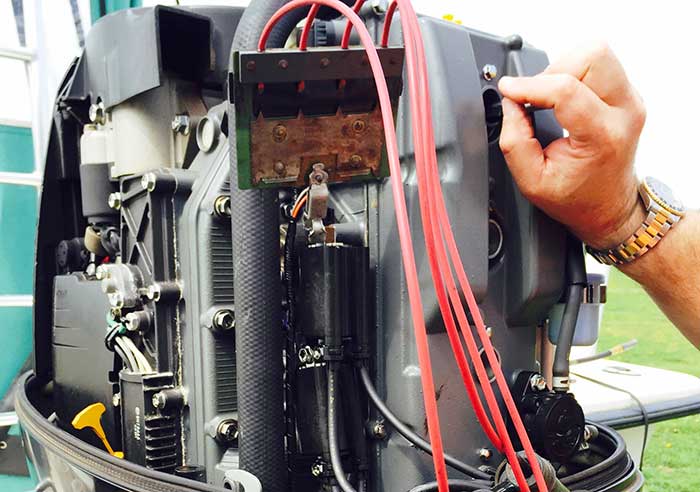
If your engine requires the kill switch to be in the go position to crank, you may have to connect a spark checker to ground the ignition properly while cranking. These are available at auto-parts and marine stores (you'll have to ask; they don't generally put these on the display shelves). Also, using the spark checker not only grounds the ignition leads to prevent ignition problems from occurring during your compression check; it allows you to visually check your engine's spark as you crank it.
3. Screw your compression gauge into the first cylinder. Make sure that the plug leads are well clear of the flywheel or any moving parts.
4. Crank the engine with the starter or pull cord through at least four or five flywheel revolutions, or until the compression-gauge needle stops advancing. The engine won't start, as the plugs have been removed, but some fuel will be injected into the cylinder, so smoking or sparks such as from connected grounded spark plugs could ignite these gases. If you have a fuel-injection engine, the injectors are spraying very dangerous gas vapor into the cylinders unless your system provides a way to safely stop this.
5. Note the reading for that cylinder.
6. Repeat the process for each cylinder and note the results.
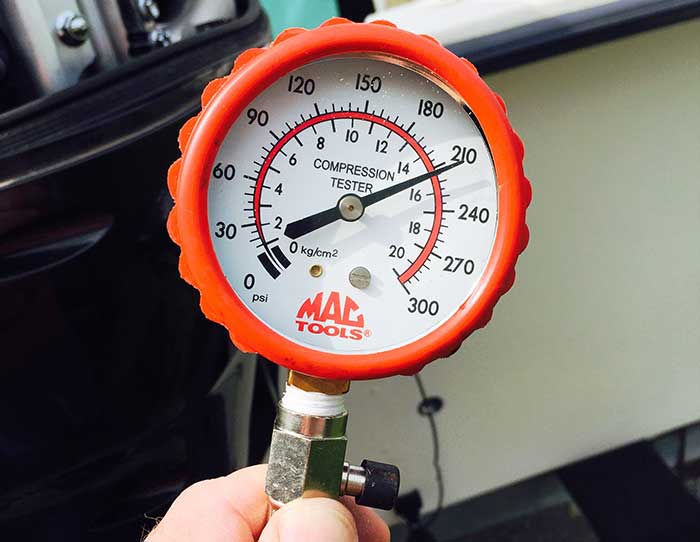
This Suzuki DF115's cranking compression readings were all within five PSI of each other, at approximately 210 PSI, indicating a healthy engine.
Interpreting Your Results
Not many engine manufacturers will give a cranking compression reference standard for their engines. There are too many variables. What they typically write in service manuals is that the readings should all be within 10 PSI of each other. While that's helpful, it's frustrating to not have a reference when performing the test on your engine. If in doubt about your readings, talk with your dealer to see if they're in the ballpark. Generally, readings below 90 PSI for modern two-stroke outboards indicate a problem; most will produce cranking compression readings in the 90 to 105 PSI range, depending on the engine year, make, and model. For older models and high-performance engines, readings should usually be in the 115 to 140 PSI range, again depending on the engine make, year, and model. Four-stroke engines can produce much higher compression; check the readings we got for our subject engine, a 2006 Suzuki DF115. Again, the readings should be within 10 PSI of each other.
If your compression readings are low, or some cylinders low but others high, there are a few potential causes. The most common issue is carbon clogging the piston-ring grooves. The carbon residue is the byproduct of the combustion cycle. Left to build up, it causes the piston-rings to stick so that they can't "spring out" against the cylinder walls to seal combustion pressure and transfer heat. Engine damage will result if the condition isn't rectified. Adding products like Ring Free and Engine Tuner to the fuel, or spraying an appropriate product directly into the engine air intakes with the engine running, may help to dissolve some carbon deposits, although you should consult your engine manufacturer first. However, this isn't a cure-all. Sometimes the deposits are so hard, old, and crusty that the engine must be disassembled, cleaned, and rebuilt.
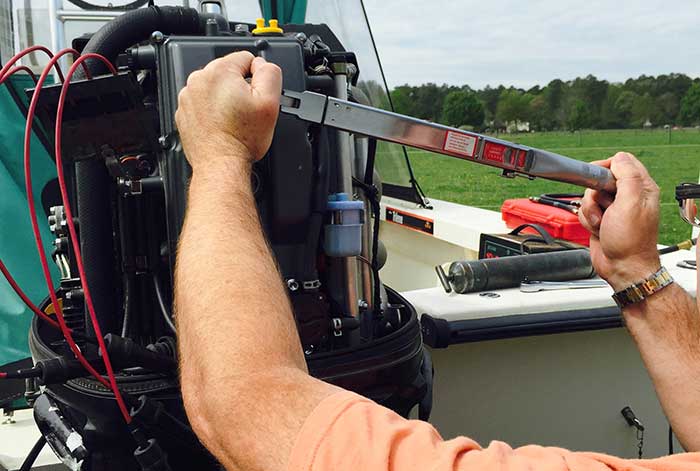
When performing a compression check, it's a good time to purchase, gap, and install new spark plugs. Buy the correct ones, and gap them according to the specification for your engine. Torquing the plugs in place with a torque wrench is the best way to ensure that they're tight enough without stripping the threads.
The engine could be worn out, i.e., the cylinders worn out-of-round, tapered, or both. If this is the case, it's more likely that all cylinder readings will be low, not just one or two.
There could be internal damage, perhaps a broken piston ring, or scored cylinder, or broken or detonated piston, a bad valve seating, even a broken connecting rod. In this case, the suspect cylinder's compression would be dramatically lower than the rest, or even zero.
Tip
If your test reveals low or erratic readings, you may need to remove the engine cylinder head(s) to inspect the piston/cylinder condition. It's at this point, however, that you might want to defer to your mechanic, if you haven't already. If you did a compression check, at least you can relay your findings to the dealer.
If your engine produces healthy, even readings, record this information for future reference as a baseline. Also, these results will be helpful if you're selling your engine.
While this seems like a fairly basic test, the specifics can vary greatly with the many variations of outboards and systems. Failure to follow steps appropriate to your outboard may cause damage and injury. Unless you're familiar with your motor's requirements and have a good understanding of how to do this, you may want to leave it to a trained outboard mechanic.
